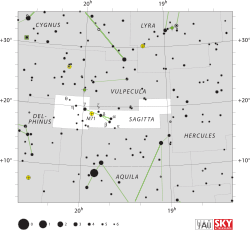Theta Sagittae

| |
| Observation data Epoch J2000.0 Equinox J2000.0 (ICRS) | |
|---|---|
| Constellation | Sagitta |
| Right ascension | 20h 09m 56.6468s[1] |
| Declination | +20° 54′ 54.098″[1] |
| Apparent magnitude (V) | +6.48[2] |
| Characteristics | |
| Spectral type | F5 IV[3] |
| U−B color index | −0.04[1] |
| B−V color index | +0.38[1] |
| Astrometry | |
| Radial velocity (Rv) | −43.0[4] km/s |
| Proper motion (μ) | RA: +59.68[5] mas/yr Dec.: +98.43[5] mas/yr |
| Parallax (π) | 22.15 ± 0.43[5] mas |
| Distance | 147 ± 3 ly (45.1 ± 0.9 pc) |
| Details | |
| Mass | 1.52[6] M☉ |
| Surface gravity (log g) | 4.32[6] cgs |
| Temperature | 6,750±229[6] K |
| Metallicity [Fe/H] | −0.17[4] dex |
| Rotational velocity (v sin i) | 33.6[7] km/s |
| Age | 2.089[6] Gyr |
| Other designations | |
| Database references | |
| SIMBAD | data |
Theta Sagittae (θ Sagittae) is a double star[9] in the northern constellation of Sagitta. With an apparent visual magnitude of +6.48,[2] it is near the limit of stars that can be seen with the naked eye. According to the Bortle scale the star is visible in dark suburban/rural skies. Based upon an annual parallax shift of 22.15 mas as seen from Earth,[5] it is located roughly 147 light years from the Sun.
The primary, component A,[10] is an F-type subgiant star with a stellar classification of F5 IV.[3] This star is about two[6] billion years old with 52%[6] more mass than the Sun. It forms a double star with a magnitude 8.85[10] companion, which is located at an angular separation of 11.58 arc seconds along a position angle of 331.1°, as of 2011.[9]
References
- 1 2 3 4 Gaia Collaboration; et al. (November 2016), "Gaia Data Release 1. Summary of the astrometric, photometric, and survey properties", Astronomy & Astrophysics, 595: 23, Bibcode:2016A&A...595A...2G, doi:10.1051/0004-6361/201629512, A2.
- 1 2 Nicolet, B. (1978), "Photoelectric photometric Catalogue of homogeneous measurements in the UBV System", Astronomy and Astrophysics Supplement Series, 34: 1–49, Bibcode:1978A&AS...34....1N.
- 1 2 Harlan, E. A. (September 1969), "MK classifications for F- and G-type stars. I", Astronomical Journal, 74: 916–919, Bibcode:1969AJ.....74..916H, doi:10.1086/110881.
- 1 2 Casagrande, L.; et al. (2011), "New constraints on the chemical evolution of the solar neighbourhood and Galactic disc(s). Improved astrophysical parameters for the Geneva-Copenhagen Survey", Astronomy & Astrophysics, 530 (A138): 21, Bibcode:2011A&A...530A.138C, arXiv:1103.4651
 , doi:10.1051/0004-6361/201016276.
, doi:10.1051/0004-6361/201016276. - 1 2 3 4 van Leeuwen, F. (2007), "Validation of the new Hipparcos reduction", Astronomy and Astrophysics, 474 (2): 653–664, Bibcode:2007A&A...474..653V, arXiv:0708.1752
 , doi:10.1051/0004-6361:20078357.
, doi:10.1051/0004-6361:20078357. - 1 2 3 4 5 6 David, Trevor J.; Hillenbrand, Lynne A. (2015), "The Ages of Early-Type Stars: Strömgren Photometric Methods Calibrated, Validated, Tested, and Applied to Hosts and Prospective Hosts of Directly Imaged Exoplanets", The Astrophysical Journal, 804 (2): 146, Bibcode:2015ApJ...804..146D, arXiv:1501.03154
 , doi:10.1088/0004-637X/804/2/146.
, doi:10.1088/0004-637X/804/2/146. - ↑ do Nascimento, J. D., Jr.; et al. (July 2003), "On the link between rotation, chromospheric activity and Li abundance in subgiant stars", Astronomy and Astrophysics, 405: 723–731, Bibcode:2003A&A...405..723D, arXiv:astro-ph/0307196
 , doi:10.1051/0004-6361:20030633.
, doi:10.1051/0004-6361:20030633. - ↑ "tet Sge". SIMBAD. Centre de données astronomiques de Strasbourg. Retrieved 2017-07-10.
- 1 2 Mason, Brian D.; et al. (May 2012), "Speckle Interferometry at the U.S. Naval Observatory. XVIII", The Astronomical Journal, 143 (5): 6, Bibcode:2012AJ....143..124M, doi:10.1088/0004-6256/143/5/124, 124.
- 1 2 Mason, B. D.; et al. (2014), The Washington Visual Double Star Catalog, Bibcode:2001AJ....122.3466M, doi:10.1086/323920